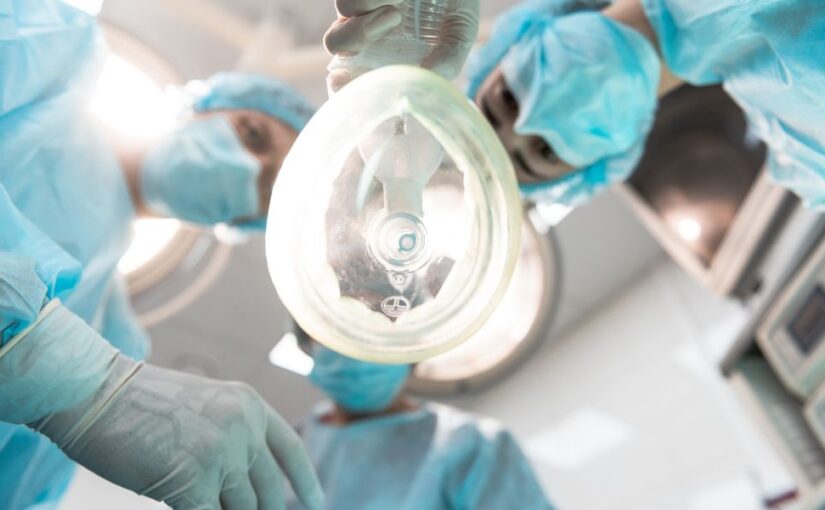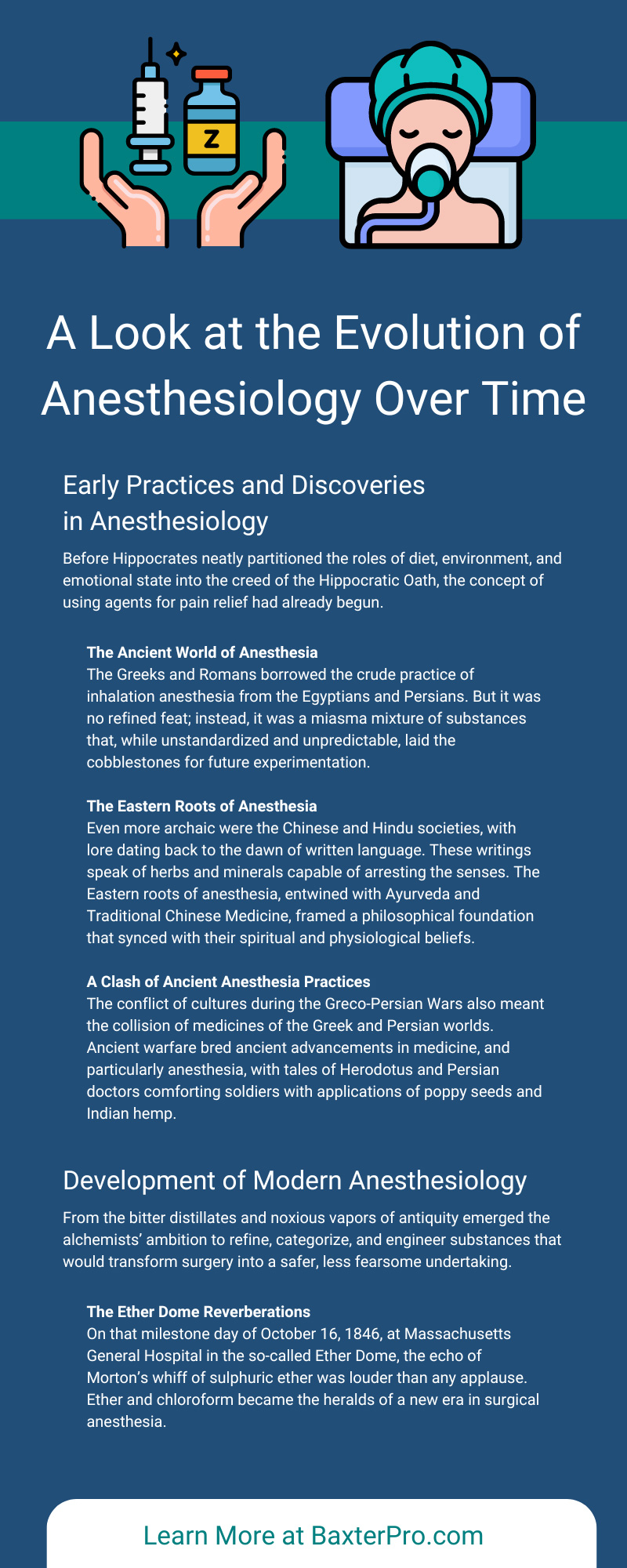
A Look at the Evolution of Anesthesiology Over Time
May 07 2024Every year, more than 40 million patients in North America experience anesthesia in some form, according to the National Institutes of Health. And this number seems to increase every year. Peering through the annals of history, we can see the paramount role of anesthesiology in the progression of modern medicine. This silent yet pivotal science is the saga of human ingenuity, innovation, and compassionate care.
Below, we take you through anesthesiology over time so that you can look at its remarkable evolution from its simple origins thousands of years ago to the complex medicine of today. You’ll learn about the ancient world of anesthesia, its contemporary development, and the future of the vital medicine.
What Is Anesthesiology, and Why Does Its History Matter?
Before we plunge into the depths of its evolution, we lay the groundwork. Anesthesiology is the intricate science of balancing consciousness and unconsciousness. It encompasses the development, application, and ongoing research of anesthetics—the essential assistant of modern surgery.
Understanding its past is crucial for appreciating how anesthesiology weaves through the tapestry of medical advancements. The steady crescendo of progress brings us to modern anesthetic techniques, intricate health monitoring, and the expanding frontier of pharmaceutical innovation. If you’re an anesthesiologist, nurse anesthetist, or anesthesiology student, you need to familiarize yourself with the origins of the practice to understand how far we’ve come.
Early Practices and Discoveries in Anesthesiology
Before Hippocrates neatly partitioned the roles of diet, environment, and emotional state into the creed of the Hippocratic Oath, the concept of using agents for pain relief had already begun.
The Ancient World of Anesthesia
The Greeks and Romans borrowed the crude practice of inhalation anesthesia from the Egyptians and Persians. But it was no refined feat; instead, it was a miasma mixture of substances that, while unstandardized and unpredictable, laid the cobblestones for future experimentation.
The Eastern Roots of Anesthesia
Even more archaic were the Chinese and Hindu societies, with lore dating back to the dawn of written language. These writings speak of herbs and minerals capable of arresting the senses. The Eastern roots of anesthesia, entwined with Ayurveda and Traditional Chinese Medicine, framed a philosophical foundation that synced with their spiritual and physiological beliefs.
A Clash of Ancient Anesthesia Practices
The conflict of cultures during the Greco-Persian Wars also meant the collision of medicines of the Greek and Persian worlds. Ancient warfare bred ancient advancements in medicine, and particularly anesthesia, with tales of Herodotus and Persian doctors comforting soldiers with applications of poppy seeds and Indian hemp.
Development of Modern Anesthesiology
From the bitter distillates and noxious vapors of antiquity emerged the alchemists’ ambition to refine, categorize, and engineer substances that would transform surgery into a safer, less fearsome undertaking.
The Ether Dome Reverberations
On that milestone day of October 16, 1846, at Massachusetts General Hospital in the so-called Ether Dome, the echo of Morton’s whiff of sulphuric ether was louder than any applause. Ether and chloroform became the heralds of a new era in surgical anesthesia.
The Curious Case of Curare Conundrum
While not an anesthetic in the true sense, the curare drug’s blockade of the neuromuscular junction disrupted the clench of spastic muscles during surgery. This highlighted a critical intersubjectivity between anesthesiology and pharmacological innovation.
The Halothane Hierarchy
Halothane and the following fluorinated family made headlines for their potency, security, and stability. They heralded the consanguinity between synthetic chemistry and anesthesiology, reducing the ODs from the medicine often used before.
Anesthesiology in Contemporary Medicine
As we jump from historical reflections to the mirrored walls of the contemporary operating room, we can see that anesthesiology has become indispensable in the domain of surgical miracles.
From Observations to Oscillography
The stethoscopes and a good, watchful eye on the patient gave way to a flurry of modern monitoring techniques, from capnography to bispectral analysis. This offered anesthesiologists a better look at physiology by enhancing visibility in kinetic responses and metabolic trends to increase patient safety and exploration.
The Advancement of Precise Anesthetic Delivery
The precision in anesthetic delivery now allies with engineered diligence, vaporizers, laryngeal mask airways, and developments like the Supraglottic Airway Management. These technological tethers equip the anesthesiologist to anticipate airway intricacies with an almost clairvoyant confidence.
The Articulation of Emergence and Calibration
The wake-up and shake-up strategy in anesthesiology is a contemporary approach to postoperative care, focusing on accelerated recovery protocols that facilitate quicker patient awakening and mobilization after surgery. This paradigm shift underscores the meticulous calibration of anesthesia to optimize patient outcomes, reduce the incidence of postoperative complications, and enhance the overall recovery experience. Through this process, anesthesiologists can assure patient comfort and safety during surgery and significantly contribute to their swift return to normalcy.
The Future of Anesthesiology
Now that we’ve seen the evolution of anesthesiology over time, we can finally look to the future and the many possibilities that the study of anesthesiology holds for health care.
The Escalating Demand for Anesthesiology in Modern Health Care
The aging population, the expanding repertoire of surgical procedures, and the desire for cosmetic surgery all portend an increasing demand for the handiwork of skilled anesthesiologists. This ensures that anesthesiologists are always in high demand.
Pharmacogenetics and the Fine Art of Individuality
The ripples of Anesthesia Wave 1.0—the General Anesthesia—will meet its own Genetic Revolution, with bespoke anesthetics tailored to an individual’s DNA landscape. This trajectory spans the spectrum from physiological variations to psychological predispositions, where the medicine of tomorrow becomes as unique as the patient it serves.
The Virtual Versatility and the Learning Curve
Virtual reality simulators and augmented reality interfaces will transform the anesthetic training and allow established professionals to rehearse their work through high-fidelity reconstructions of anatomy and scenarios.
Conclusion
We hope you’ve enjoyed our trip through the history of anesthesiology, its humble origins in medicine and science, and its modern utility and future potential. If you’re a student or nurse anesthetist in the industry, protect yourself now and in the future with nurse anesthetist malpractice insurance. Get a quote for an insurance policy online at Baxter & Associates today!




